












- Главная
- Материнские платы
- Gigabyte
Gigabyte GA-8GEM800
Gigabyte GA-8I845GE775-G
Gigabyte GA-8I915G PRO
Gigabyte GA-8I915ME-GL
Gigabyte GA-8I915PL-G
Gigabyte GA-8I945AE-AE
Gigabyte GA-8I945AEF-AE
Gigabyte GA-8I945AEF-RH-AE
Gigabyte GA-8I945EF-RH
Gigabyte GA-8I945G
Gigabyte GA-8I945G-PRO
Gigabyte GA-8I945GMBX
Gigabyte GA-8I945GME
Gigabyte GA-8I945GMF
Gigabyte GA-8IPE1000-G
Gigabyte GA-945GCM-S2
Gigabyte GA-965GM-S2
Gigabyte GA-965P-DQ6
Gigabyte GA-965P-DS3
Gigabyte GA-965P-DS3P
Gigabyte GA-965P-DS4
Gigabyte GA-965P-S3
- 1
- 2
- »
One of the next steps in the repair of any board will be the search for a circuit for the repaired motherboard. The presence of a circuit can greatly simplify troubleshooting, help to “bring back
to life” defective circuits of the motherboard most quickly and painlessly without resorting to “diagnostic warm-ups of bridges” and replacing parts “by guesswork”.
I want to share a list of circuits for Gigabyte motherboards. I recently found this collection of schemes on the Internet and I want to share it with you. It was published by the Brazilian
blogger Leandro. If these schemes help you in the repair, then write about it in the comments.
Most of the diagrams are presented both in PDF format and in Boardview format — this is a file (s) containing information about a certain printed circuit board: the
components located on it, the signals used, control points, and so on. BoardViewer is a program designed to view many different boardview formats. The link to the program’s website is below on
the page, be sure to download the latest version of the program from the official website.
Gigabyte Motherboard Schematics Collection:
Press the Ctrl + F keys in the browser and use the search to find your motherboard model in the list.
The list of schemes contains more than 300 models of motherboards. Use it completely free. Bookmark this page for future reference. Happy repairs!
Archives can be unpacked using WinRAR v5.91.
BoardView diagrams can be viewed with Boardview v1.2. Examples of extensions that such files can have: .asc, .bdv, .brd, .bv, .cad, .cst, .gr, .f2b, .fz,
etc.
Instruction Manuals and User Guides for GIGABYTE
Our database features more than 158 Instruction Manuals and User Guides for GIGABYTE

H310M A 2.0
User’s Manual
Rev. 1001
For more product details, please visit GIGABYTE’s website.
To reduce the impacts on global warming, the packaging materials of this product are recyclable and reusable. GIGABYTE works with you to protect the environment.
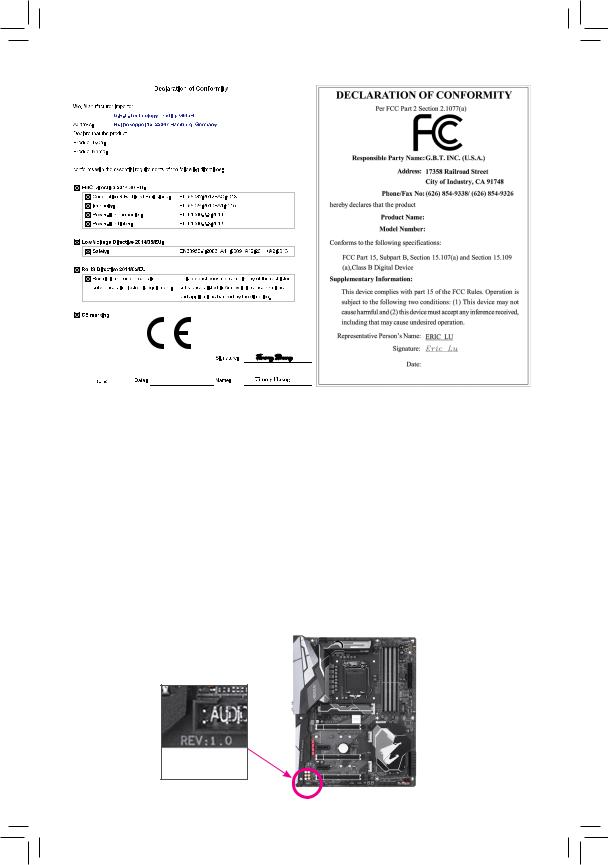
Motherboard
H310M A 2.0
Feb. 15, 2019
Motherboard
H310M A 2.0
Feb. 15, 2019
Copyright
© 2019 GIGA-BYTE TECHNOLOGY CO., LTD. All rights reserved.
The trademarks mentioned in this manual are legally registered to their respective owners.
Disclaimer
Information in this manual is protected by copyright laws and is the property of GIGABYTE.
ChangestothespecificationsandfeaturesinthismanualmaybemadebyGIGABYTEwithoutpriornotice.
No part of this manual may be reproduced, copied, translated, transmitted, or published in any form or by any means without GIGABYTE’s prior written permission.
In order to assist in the use of this product, carefully read the User’s Manual.
For product-related information, check on our website at: https://www.gigabyte.com
Identifying Your Motherboard Revision
The revision number on your motherboard looks like this: «REV: X.X.» For example, «REV: 1.0» means the revision of the motherboard is 1.0. Check your motherboard revision before updating motherboard BIOS, drivers, or when looking for technical information.
Example:

Table of Contents
|
H310M A 2.0 Motherboard Layout……………………………………………………………………….. |
4 |
|
|
Chapter 1 Hardware Installation………………………………………………………………………….. |
5 |
|
|
1-1 |
Installation Precautions…………………………………………………………………………. |
5 |
|
1-2 |
Product Specifications………………………………………………………………………….. |
6 |
|
1-3 |
Installing the CPU………………………………………………………………………………… |
9 |
|
1-4 |
Installing the Memory……………………………………………………………………………. |
9 |
|
1-5 Installing an Expansion Card……………………………………………………………….. |
10 |
|
|
1-6 |
Back Panel Connectors………………………………………………………………………. |
10 |
|
1-7 |
Internal Connectors……………………………………………………………………………. |
12 |
|
Chapter 2 BIOS Setup……………………………………………………………………………………… |
19 |
|
|
2-1 |
Startup Screen…………………………………………………………………………………… |
19 |
|
2-2 |
The Main Menu………………………………………………………………………………….. |
20 |
|
2-3 |
M.I.T…………………………………………………………………………………………………. |
21 |
|
2-4 |
System……………………………………………………………………………………………… |
27 |
|
2-5 |
BIOS………………………………………………………………………………………………… |
28 |
|
2-6 |
Peripherals………………………………………………………………………………………… |
31 |
|
2-7 |
Chipset……………………………………………………………………………………………… |
34 |
|
2-8 |
Power……………………………………………………………………………………………….. |
35 |
|
2-9 |
Save & Exit……………………………………………………………………………………….. |
37 |
|
Chapter 3 Appendix…………………………………………………………………………………………. |
38 |
|
|
Drivers Installation……………………………………………………………………………………….. |
38 |
|
|
Regulatory Statements…………………………………………………………………………………. |
39 |
|
|
Contact Us………………………………………………………………………………………………….. |
41 |
— 3 —
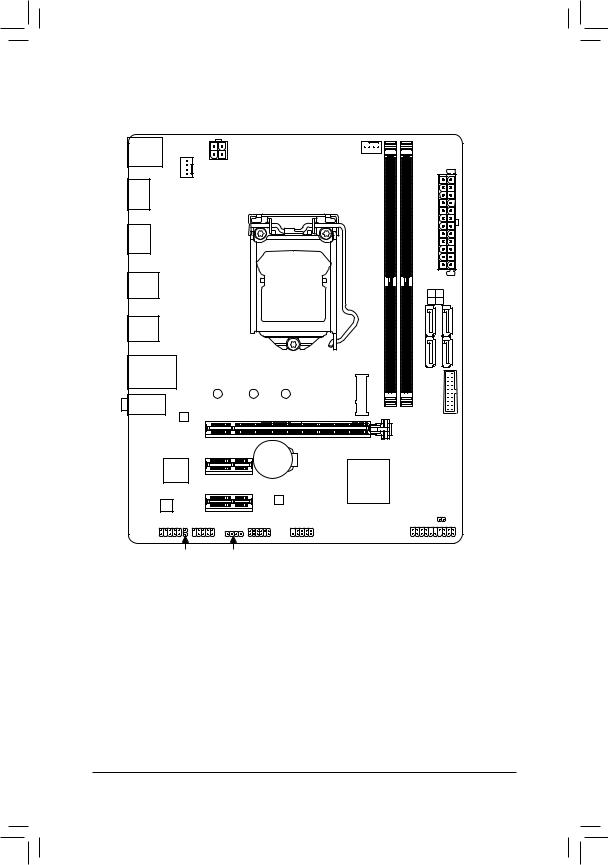
H310M A 2.0 Motherboard Layout
|
KB_MS |
CPU_FAN |
|
ATX_12V |
|
|
SYS_FAN |
|
|
DP |
|
|
LGA1151 |
|
|
HDMI |
ATX
R_USB
TYPEC
R_USB30
|
USB_LAN |
H310M A 2.0 |
||
|
80 |
60 |
42 |
|
|
AUDIO |
|||
|
Intel® |
PCIEX16 |
||
|
GbE LAN |
|||
|
PCIEX1_1 |
BAT |
||
|
iTE® |
|||
|
Super I/O |
|||
|
CODEC |
PCIEX1_2 |
||
|
M_BIOS |
|||
|
F_AUDIO COMA |
TPM |
F_USB |
|
|
SPKR |
LED_C |
|
3 2 |
|
|
1 0 |
|
|
SATA3 |
|
|
M2M |
USB30 |
|
F |
Intel® H310
CLR_CMOS
F_PANEL
Box Contents
|
55 |
H310M A 2.0 motherboard |
||
|
55 |
Motherboard driver disk |
55 |
Two SATA cables |
|
55 |
User’s Manual |
55 |
I/O Shield |
*The box contents above are for reference only and the actual items shall depend on the product package you obtain. The box contents are subject to change without notice.
—4 —

Chapter 1 Hardware Installation
1-1 Installation Precautions
The motherboard contains numerous delicate electronic circuits and components which can become damaged as a result of electrostatic discharge (ESD). Prior to installation, carefully read the user’s manual and follow these procedures:
•• Prior to installation, make sure the chassis is suitable for the motherboard.
•• Prior to installation, do not remove or break motherboard S/N (Serial Number) sticker or warranty sticker provided by your dealer. These stickers are required for warranty validation.
•• Always remove the AC power by unplugging the power cord from the power outlet before installing or removing the motherboard or other hardware components.
•• When connecting hardware components to the internal connectors on the motherboard, make sure they are connected tightly and securely.
•• When handling the motherboard, avoid touching any metal leads or connectors.
•• It is best to wear an electrostatic discharge (ESD) wrist strap when handling electronic components such as a motherboard, CPU or memory. If you do not have an ESD wrist strap, keep your hands dry and first touch a metal object to eliminate static electricity.
•• Prior to installing the motherboard, please have it on top of an antistatic pad or within an electrostatic shielding container.
•• Before connecting or unplugging the power supply cable from the motherboard, make sure the power supply has been turned off.
•• Before turning on the power, make sure the power supply voltage has been set according to the local voltage standard.
•• Before using the product, please verify that all cables and power connectors of your hardware components are connected.
•• To prevent damage to the motherboard, do not allow screws to come in contact with the motherboard circuit or its components.
•• Make sure there are no leftover screws or metal components placed on the motherboard or within the computer casing.
•• Do not place the computer system on an uneven surface.
•• Do not place the computer system in a high-temperature or wet environment.
•• Turning on the computer power during the installation process can lead to damage to system components as well as physical harm to the user.
•• If you are uncertain about any installation steps or have a problem related to the use of the product, please consult a certified computer technician.
•• If you use an adapter, extension power cable, or power strip, ensure to consult with its installation and/or grounding instructions.
— 5 —

|
1-2 |
Product Specifications |
|
|
CPU |
Support for 9th and 8th Generation Intel® Core™ i9 processors/Intel® Core™ i7 |
|
|
processors/Intel® Core™ i5 processors/Intel® Core™ i3 processors/Intel® Pentium® |
||
|
processors/Intel® Celeron® processors in the LGA1151 package |
||
|
(Go to GIGABYTE’s website for the latest CPU support list.) |
||
|
L3 cache varies with CPU |
||
|
Chipset |
Intel® H310 Express Chipset |
|
|
Memory |
2 x DDR4 DIMM sockets supporting up to 32 GB of system memory |
|
|
Dual channel memory architecture |
||
|
Support for DDR4 2666/2400/2133 MHz memory modules |
||
|
Support for ECC Un-buffered DIMM 1Rx8/2Rx8 memory modules (operate in |
||
|
non-ECC mode) |
||
|
Support for non-ECC Un-buffered DIMM 1Rx8/2Rx8/1Rx16 memory modules |
||
|
Support for Extreme Memory Profile (XMP) memory modules |
*To support 2666 MHz or XMP memory, you must install a 9th or 8th Generation Intel® Core™ i9/i7/i5 processor.
(Go to GIGABYTE’s website for the latest supported memory speeds and memory modules.)
|
Onboard |
Integrated Graphics Processor-Intel® HD Graphics support: |
||
|
Graphics |
— |
1 x DisplayPort, supporting a maximum resolution of 4096×2304@60 Hz |
|
|
* |
Support for DisplayPort 1.2 version, HDCP 2.2, and HDR. |
||
|
— |
1 x HDMI port, supporting a maximum resolution of 4096×2160@30 Hz |
||
|
* |
Support for HDMI 1.4 version and HDCP 2.2. |
Support for up to dual displays at the same timeMaximum shared memory of 1 GB
|
Audio |
Realtek® ALC887 codec |
|
|
High Definition Audio |
||
|
2/4/5.1/7.1-channel |
*To configure 7.1-channel audio, you have to use an HD front panel audio module and enable the multi-channel audio feature through the audio driver.
|
Support for S/PDIF Out |
|||
|
LAN |
Intel® GbE LAN chip (10/100/1000 Mbit) |
||
|
Expansion Slots |
1 x PCI Express x16 slot, running at x16 |
||
|
(The PCI Express x16 slot conforms to PCI Express 3.0 standard.) |
|||
|
2 x PCI Express x1 slots |
|||
|
(All of the PCI Express x1 slots conform to PCI Express 2.0 standard.) |
|||
|
Storage Interface |
Chipset: |
||
|
— |
1 x M.2 connector (Socket 3, M key, type 2242/2260/2280 SATA and PCIe |
||
|
x4/x2 SSD support) |
|||
|
— |
4 x SATA 6Gb/s connectors |
||
|
* Refer to «1-7 Internal Connectors,» for the installation notices for the M.2 and SATA |
|||
|
connectors. |
— 6 —

|
USB |
Chipset: |
|
— 1 x USB Type-C™ port on the back panel, with USB 3.1 Gen 1 support |
|
|
— 3 x USB 3.1 Gen 1 ports (1 port on the back panel, 2 ports available through |
|
|
the internal USB header) |
|
|
— 6 x USB 2.0/1.1 ports (4 ports on the back panel, 2 ports available through |
|
|
the internal USB header) |
1 x 24-pin ATX main power connector1 x 4-pin ATX 12V power connector1 x CPU fan header
1 x system fan header
1 x RGB LED strip header4 x SATA 6Gb/s connectors1 x M.2 Socket 3 connector1 x front panel header
1 x front panel audio header1 x USB 3.1 Gen 1 header1 x USB 2.0/1.1 header
1 x speaker header
1 x Trusted Platform Module (TPM) header (2×6 pin, for the GC-TPM2.0_S module only)
1 x serial port header1 x Clear CMOS jumper
|
Back Panel |
1 x PS/2 mouse port |
|
|
Connectors |
1 x PS/2 keyboard port |
|
|
1 x DisplayPort |
||
|
1 x HDMI port |
||
|
1 x USB Type-C™ port, with USB 3.1 Gen 1 support |
||
|
1 x USB 3.1 Gen 1 port |
||
|
4 x USB 2.0/1.1 ports |
||
|
1 x RJ-45 port |
||
|
3 x audio jacks |
||
|
I/O Controller |
iTE® I/O Controller Chip |
Voltage detection
Temperature detectionFan speed detectionOverheating warningFan fail warning
Fan speed control
*Whether the fan speed control function is supported will depend on the cooler you install.
|
BIOS |
1 x 128 Mbit flash |
|
|
Use of licensed AMI UEFI BIOS |
||
|
PnP 1.0a, DMI 2.7, WfM 2.0, SM BIOS 2.7, ACPI 5.0 |
— 7 —
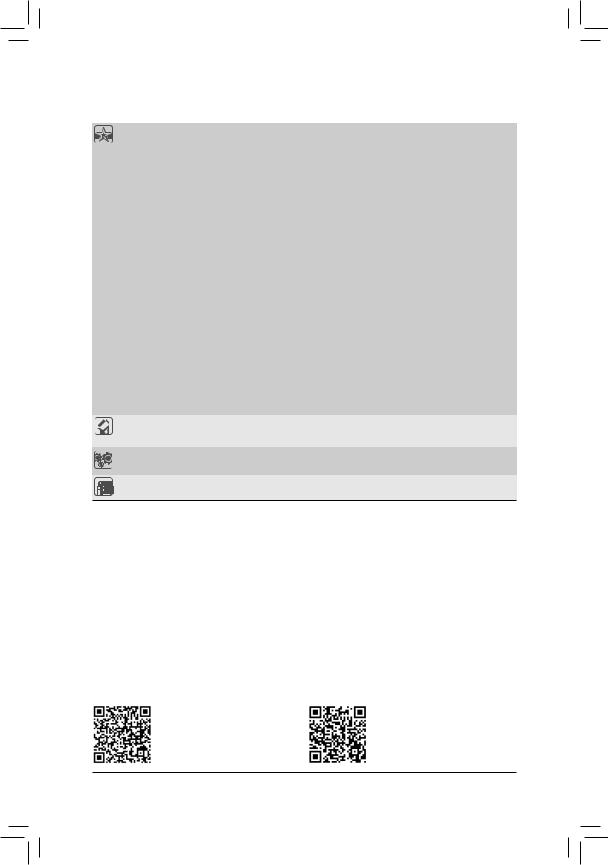
|
Unique Features |
Support for APP Center |
|||
|
* Available applications in APP Center may vary by motherboard model. Supported |
||||
|
functionsofeachapplicationmayalsovarydependingonmotherboardspecifications. |
||||
|
— |
3D OSD |
|||
|
— |
@BIOS |
|||
|
— |
AutoGreen |
|||
|
— |
Cloud Station |
|||
|
— |
EasyTune |
|||
|
— |
Fast Boot |
|||
|
— |
Game Boost |
|||
|
— |
ON/OFF Charge |
|||
|
— |
Platform Power Management |
|||
|
— |
RGB Fusion |
|||
|
— |
Smart Backup |
|||
|
— |
Smart Keyboard |
|||
|
— |
Smart TimeLock |
|||
|
— |
Smart HUD |
|||
|
— |
Smart Survey |
|||
|
— |
System Information Viewer |
|||
|
— |
USB Blocker |
|||
|
Support for Q-Flash |
||||
|
Support for Xpress Install |
||||
|
Bundled |
Norton® Internet Security (OEM version) |
|||
|
Software |
cFosSpeed |
|||
|
Operating |
Support for Windows 10 64-bit |
|||
|
System |
||||
|
Form Factor |
Micro ATX Form Factor; 22.6cm x 18.5cm |
*GIGABYTE reserves the right to make any changes to the product specifications and product-related information without prior notice.
Please visit GIGABYTE’s website for support lists of CPU, memory modules, SSDs, and M.2 devices.
— 8 —
Please visit the Support\Utility List page on GIGABYTE’s website to download the latest version of apps.
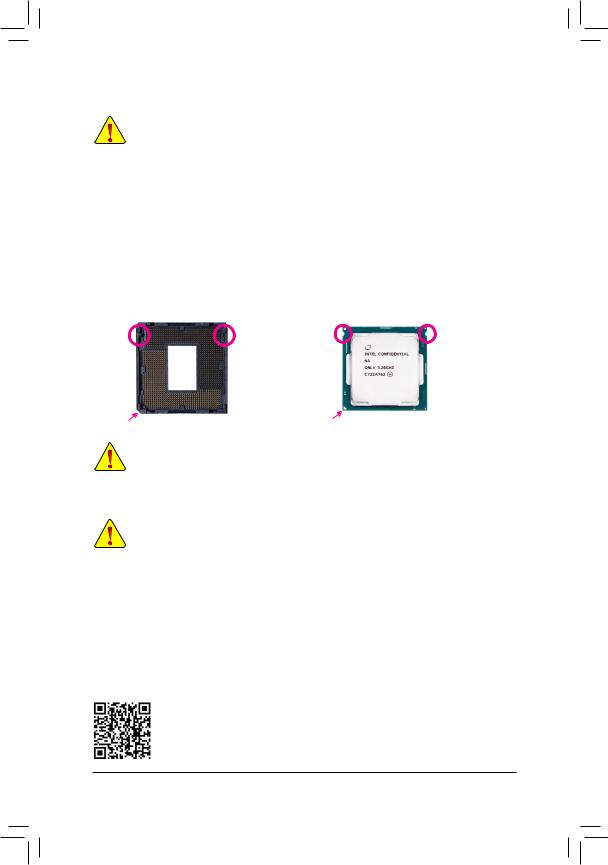
1-3 Installing the CPU
Read the following guidelines before you begin to install the CPU:
•• Make sure that the motherboard supports the CPU. (Go to GIGABYTE’s website for the latest CPU support list.)
•• Always turn off the computer and unplug the power cord from the power outlet before installing the CPU to prevent hardware damage.
•• Locate the pin one of the CPU. The CPU cannot be inserted if oriented incorrectly. (Or you may locate the notches on both sides of the CPU and alignment keys on the CPU socket.)
•• Apply an even and thin layer of thermal grease on the surface of the CPU.
•• Do not turn on the computer if the CPU cooler is not installed, otherwise overheating and damage of the CPU may occur.
•• Set the CPU host frequency in accordance with the CPU specifications. It is not recommended that the system bus frequency be set beyond hardware specifications since it does not meet the standard requirementsfortheperipherals.Ifyouwishtosetthefrequencybeyondthestandardspecifications,please dosoaccordingtoyourhardwarespecificationsincludingtheCPU,graphicscard,memory,harddrive,etc.
Installing the CPU
Locate the alignment keys on the motherboard CPU socket and the notches on the CPU.
|
LGA1151 CPU Socket |
LGA1151 CPU |
||
|
Alignment Key |
Alignment Key |
Notch |
Notch |
|
Pin One Corner of the CPU Socket |
Triangle Pin One Marking on the CPU |
Do not remove the CPU socket cover before inserting the CPU. It may pop off from the load plate automatically during the process of re-engaging the lever after you insert the CPU.
1-4 Installing the Memory
Read the following guidelines before you begin to install the memory:
•• Make sure that the motherboard supports the memory. It is recommended that memory of the same capacity, brand, speed, and chips be used.
(Go to GIGABYTE’s website for the latest supported memory speeds and memory modules.)
•• Always turn off the computer and unplug the power cord from the power outlet before installing the memory to prevent hardware damage.
•• Memory modules have a foolproof design. A memory module can be installed in only one direction. If you are unable to insert the memory, switch the direction.
Dual Channel Memory Configuration
This motherboard provides two memory sockets and supports Dual Channel Technology. After the memory is installed, the BIOS will automatically detect the specifications and capacity of the memory. Enabling Dual
Channel memory mode will double the original memory bandwidth.
Please visit GIGABYTE’s website for details on hardware installation.
— 9 —

The two memory sockets are divided into two channels and each channel has one memory socket as following:
Channel A: DDR4_1Channel B: DDR4_2
Due to CPU limitations, read the following guidelines before installing the memory in Dual Channel mode.
1.Dual Channel mode cannot be enabled if only one memory module is installed.
2.When enabling Dual Channel mode with two memory modules, it is recommended that memory of the same capacity, brand, speed, and chips be used.
1-5 Installing an Expansion Card
Read the following guidelines before you begin to install an expansion card:
•• Make sure the motherboard supports the expansion card. Carefully read the manual that came with your expansion card.
•• Always turn off the computer and unplug the power cord from the power outlet before installing an expansion card to prevent hardware damage.
1-6 Back Panel Connectors
PS/2 Keyboard and PS/2 Mouse Port
Use the upper port (green) to connect a PS/2 mouse and the lower port (purple) to connect a PS/2 keyboard.
DisplayPort
DisplayPort delivers high quality digital imaging and audio, supporting bi-directional audio transmission. DisplayPort can support both DPCP and HDCP 2.2 content protection mechanisms. It provides improved visuals supporting Rec. 2020 (Wide Color Gamut) and High Dynamic Range (HDR) for Blu-ray UHD playback. You can use this port to connect your DisplayPort-supported monitor. Note: The DisplayPort Technology can support a maximum resolution of 4096×2304@60 Hz but the actual resolutions supported depend on the monitor being used.
HDMI Port



USB 2.0/1.1 Port
The USB port supports the USB 2.0/1.1 specification. Use this port for USB devices.
— 10 —
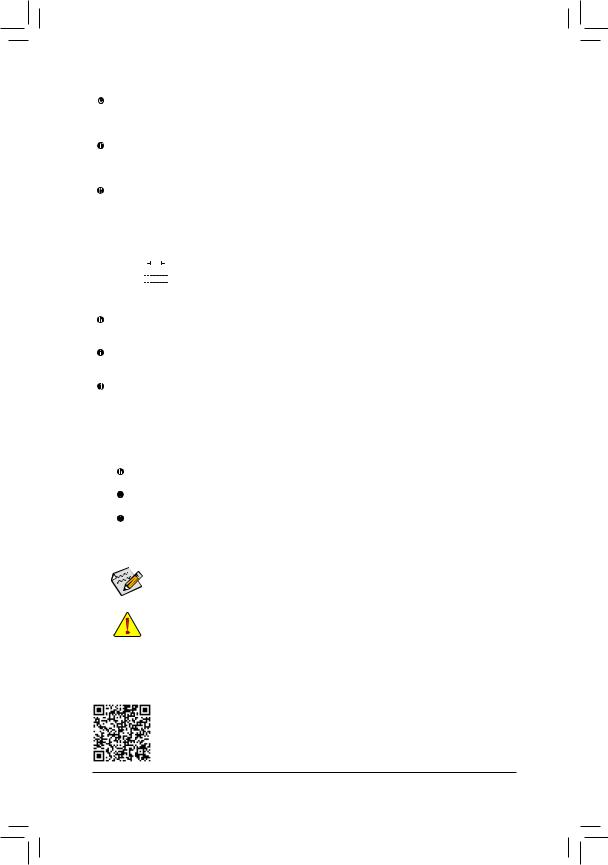
USB 3.1 Gen 1 Port
The USB 3.1 Gen 1 port supports the USB 3.1 Gen 1 specification and is compatible to the USB 2.0 specification. Use this port for USB devices.
USB Type-C™ Port
The USB 3.1 Gen 1 port supports the USB 3.1 Gen 1 specification and is compatible to the USB 2.0 specification. Use this port for USB devices.
RJ-45 LAN Port
The Gigabit Ethernet LAN port provides Internet connection at up to 1 Gbps data rate. The following describes the states of the LAN port LEDs.
|
Connection/ |
Connection/Speed LED: |
Activity LED: |
|||||||||||||||||
|
Speed LED |
Activity LED |
||||||||||||||||||
|
State |
Description |
State |
Description |
||||||||||||||||
|
Orange |
1 Gbps data rate |
Blinking |
Data transmission or receiving is occurring |
||||||||||||||||
|
Green |
100 Mbps data rate |
On |
No data transmission or receiving is occurring |
||||||||||||||||
|
Off |
10 Mbps data rate |
||||||||||||||||||
|
LAN Port |
|||||||||||||||||||
Line In/Rear Speaker Out (Blue)
The line in jack. Use this audio jack for line in devices such as an optical drive, walkman, etc.
Line Out/Front Speaker Out (Green)
The line out jack.
Mic In/Center/Subwoofer Speaker Out (Pink)
The Mic in jack.
Audio Jack Configurations:
|
Jack |
Headphone/ |
4-channel |
5.1-channel |
7.1-channel |
|
|
2-channel |
|||||
|
Line In/Rear Speaker Out |
a |
a |
a |
||
|
Line Out/Front Speaker Out |
a |
a |
a |
a |
|
|
Mic In/Center/Subwoofer |
a |
a |
|||
|
Speaker Out |
|||||
|
Front Panel Line Out/Side |
a |
||||
|
Speaker Out |
|||||
To configure 7.1-channel audio, you have to use an HD front panel audio module and enable the multi-channel audio feature through the audio driver.
•• When removing the cable connected to a back panel connector, first remove the cable from your device and then remove it from the motherboard.
•• When removing the cable, pull it straight out from the connector. Do not rock it side to side to prevent an electrical short inside the cable connector.
Please visit GIGABYTE’s website for details on configuring the audio software.
— 11 —
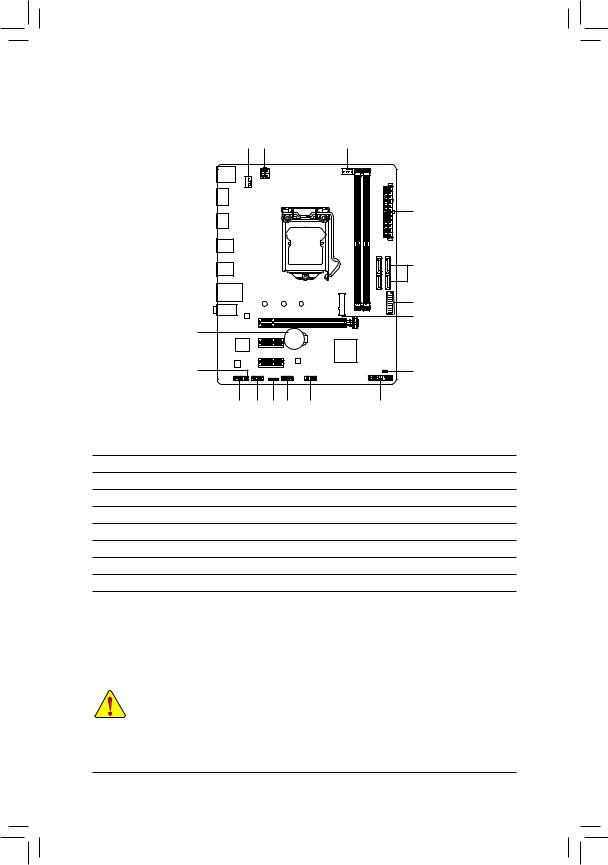
|
1-7 |
Internal Connectors |
|||||
|
4 |
1 |
3 |
||||
|
2 |
||||||
|
7 |
||||||
|
10 |
||||||
|
6 |
||||||
|
15 |
||||||
|
16 |
14 |
|||||
|
9 |
12 |
5 |
13 |
11 |
8 |
|
|
1) |
ATX_12V |
9) |
F_AUDIO |
|||
|
2) |
ATX |
10) |
F_USB30 |
|||
|
3) |
CPU_FAN |
11) |
F_USB |
|||
|
4) |
SYS_FAN |
12) |
COMA |
|||
|
5) |
LED_C |
13) |
TPM |
|||
|
6) |
M2M |
14) |
CLR_CMOS |
|||
|
7) |
SATA3 0/1/2/3 |
15) |
BAT |
|||
|
|
F_PANEL |
16) |
SPKR |
Read the following guidelines before connecting external devices:
•• First make sure your devices are compliant with the connectors you wish to connect.
•• Before installing the devices, be sure to turn off the devices and your computer. Unplug the power cord from the power outlet to prevent damage to the devices.
•• After installing the device and before turning on the computer, make sure the device cable has been securely attached to the connector on the motherboard.
— 12 —
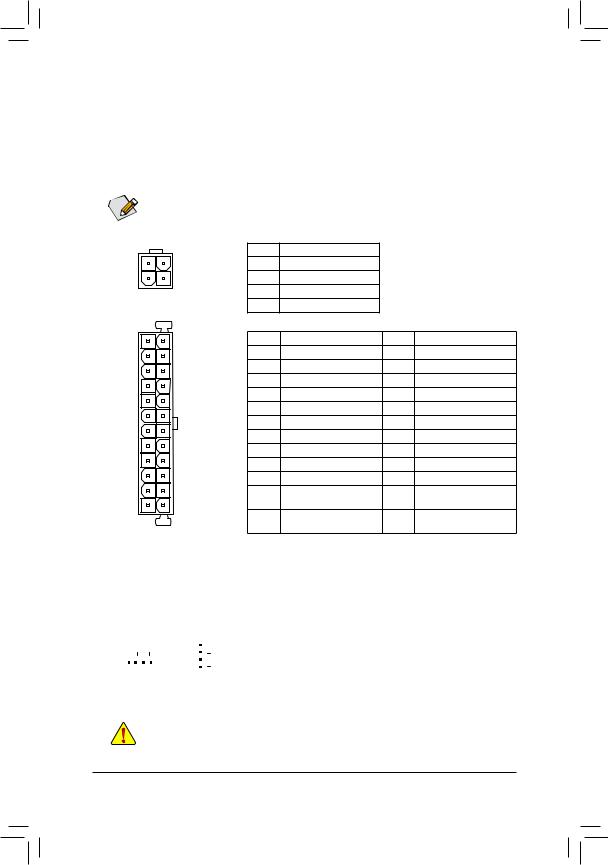
1/2) ATX_12V/ATX (2×2 12V Power Connector and 2×12 Main Power Connector)
With the use of the power connector, the power supply can supply enough stable power to all the components on the motherboard. Before connecting the power connector, first make sure the power supply is turned off and all devices are properly installed. The power connector possesses a foolproof design. Connect the power supply cable to the power connector in the correct orientation.
The 12V power connector mainly supplies power to the CPU. If the 12V power connector is not connected, the computer will not start.
To meet expansion requirements, it is recommended that a power supply that can withstand high 
required power, the result can lead to an unstable or unbootable system.
|
ATX_12V: |
|||||
|
Pin No. |
Definition |
||||
|
3 |
4 |
1 |
GND |
||
|
1 |
2 |
2 |
GND |
||
|
ATX_12V |
3 |
+12V |
|||
|
4 |
+12V |
||||
|
ATX: |
|||||
|
12 |
24 |
Pin No. |
Definition |
Pin No. |
Definition |
|
1 |
3.3V |
13 |
3.3V |
||
|
2 |
3.3V |
14 |
-12V |
||
|
3 |
GND |
15 |
GND |
||
|
4 |
+5V |
16 |
PS_ON (soft On/Off) |
||
|
5 |
GND |
17 |
GND |
||
|
6 |
+5V |
18 |
GND |
||
|
7 |
GND |
19 |
GND |
||
|
8 |
Power Good |
20 |
NC |
||
|
9 |
5VSB (stand by +5V) |
21 |
+5V |
||
|
10 |
+12V |
22 |
+5V |
||
|
11 |
+12V (Only for 2×12-pin |
23 |
+5V (Only for 2×12-pin |
||
|
1 |
13 |
ATX) |
ATX) |
||
|
12 |
3.3V (Only for 2×12-pin |
24 |
GND (Only for 2×12-pin |
||
|
ATX |
ATX) |
ATX) |
|||
3/4) CPU_FAN/SYS_FAN (Fan Headers)
All fan headers on this motherboard are 4-pin. Most fan headers possess a foolproof insertion design. When connecting a fan cable, be sure to connect it in the correct orientation (the black connector wire is the ground wire). The speed control function requires the use of a fan with fan speed control design. For optimum heat dissipation, it is recommended that a system fan be installed inside the chassis.
|
Pin No. |
Definition |
||||||||
|
1 |
1 |
GND |
|||||||
|
1 |
2 |
Voltage Speed Control |
|||||||
|
CPU_FAN |
SYS_FAN |
3 |
Sense |
||||||
|
4 |
PWM Speed Control |
•• Be sure to connect fan cables to the fan headers to prevent your CPU and system from overheating. Overheating may result in damage to the CPU or the system may hang.
•• Thesefanheadersarenotconfigurationjumperblocks.Donotplaceajumpercapontheheaders.
— 13 —

| Models | Document Type |
|---|---|
|
|
User Manual |
|
|
User Manual |
|
|
User Manual |
|
|
User Manual |
|
|
User Manual |
|
|
User Manual |
|
|
User Manual |
|
|
User Manual |
|
|
User Manual |
|
|
User Manual |
|
|
User Manual |
|
|
Installation Guide |
|
|
User Manual |
|
|
User Manual |
|
|
User Manual |
|
|
User Manual |
|
|
User Manual |
|
|
User Manual |
|
|
User Manual |
|
|
Datasheet |
|
|
User Manual |
|
|
User Manual |
|
|
User Manual |
|
|
User Manual |
|
|
User Manual |
|
|
User Manual |
|
|
User Manual |
|
|
User Manual |
|
|
User Manual |
|
|
User Manual |
|
|
User Manual |
|
|
User Manual |
|
|
User Manual |
|
|
User Manual |
|
|
User Manual |
|
|
User Manual |
|
|
User Manual |
|
|
Manual |
|
|
User Manual |
|
|
User Manual |
|
|
User Manual |
|
|
User Manual |
|
|
User Manual |
|
|
Datasheet |
|
|
User Manual |
|
|
Datasheet |
|
|
Datasheet |
|
|
User Manual |
|
|
User Manual |
|
|
User Manual |
|
|
User Manual |
|
|
User Manual |
|
|
User Manual |
|
|
User Manual |
|
|
User Manual |
|
|
User Manual |
|
|
User Manual |
|
|
Datasheet |
|
|
Datasheet |
|
|
User Manual |
|
|
User Manual |
|
|
Datasheet |
|
|
Datasheet |
|
|
Datasheet |
|
|
User Manual |
|
|
Datasheet |
|
|
Datasheet |
|
|
Datasheet |
|
|
User Manual |
|
|
Datasheet |
|
|
Datasheet |
|
|
Datasheet |
|
|
Datasheet |
|
|
User Manual |
|
|
User Manual |
|
|
Datasheet |
|
|
User Manual |
|
|
User Manual |
|
|
User Manual |
|
|
Datasheet |
|
|
User Manual |
|
|
User Manual |
|
|
User Manual |
|
|
User Manual |
|
|
User Manual |
|
|
User Manual |
|
|
User Manual |
|
|
User Manual |
|
|
User Manual |
|
|
User Manual |
|
|
User Manual |
|
|
User Manual |
|
|
Datasheet |
|
|
User Manual |
|
|
User Manual |
|
|
User Manual |
|
|
User Manual |
|
|
User Manual |
|
|
User Manual |
|
|
User Manual |
|
|
User Manual |
|
|
User Manual |
|
|
User Manual |
|
|
User Manual |
|
|
User Manual |
|
|
User Manual |
|
|
User Manual |
|
|
User Manual |
|
|
User Manual |
|
|
Datasheet |
|
|
User Manual |
|
|
User Manual |
|
|
Datasheet |
|
|
Datasheet |
|
|
User Manual |
|
|
User Manual |
|
|
Datasheet |
|
|
Datasheet |
|
|
User Manual |
|
|
User Manual |
|
|
User Manual |
|
|
User Manual |
|
|
Manual |




















